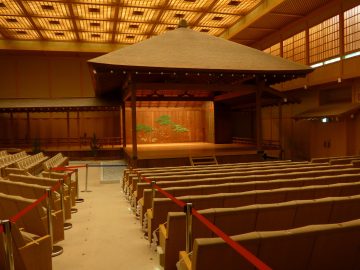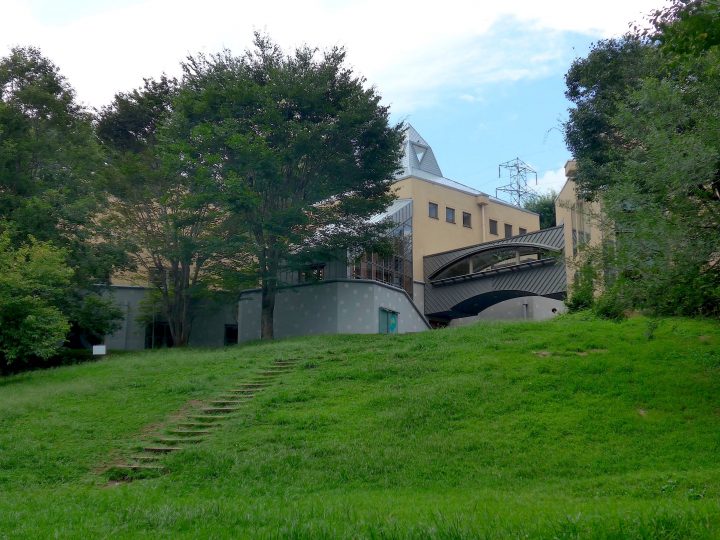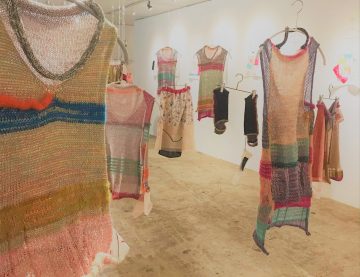Nissan Art Award 2015 | Special page
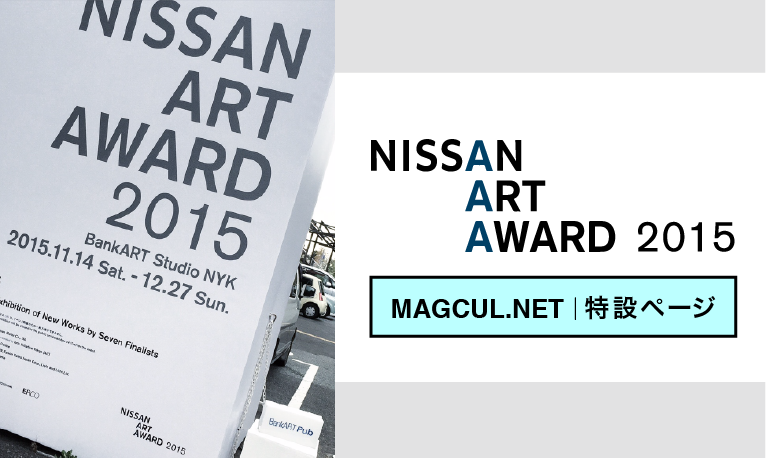
The second Nissan Art Award 2015 is currently being held at BankART Studio NYK in Yokohama.
The Nissan Art Award is given to the next generation of Japanese artists. From 33 artists recommended by art professionals, 5 international judges will select 7 finalists, and after the final screening at the venue, the Grand Prix will be decided. The Grand Prix winner will receive a prize of 3 million yen and a two-month stay in London, and it has attracted a lot of attention as an art award of a scale unprecedented in Japan. The seven finalists are Sayaka Akiyama, Tsuyoshi Hisakado, Hisashi Ishida, Takahiro Iwasaki, Futoshi Miyagi, Yuko Mori, and Tomoko Yoneda. On this page, we will introduce the exhibition with photos, and we will also publish an interview with Yuko Mori, the winner of the Grand Prix!
Introducing the finalists' works
We will introduce some of the exhibiting artists and their works with photos. *The following text is taken from the list of exhibited works distributed at the venue.
Sayaka Akiyama
http://www.nissan-global.com/JP/CITIZENSHIP/NAA/FINALIST/01/
Akiyama has lived and walked in various places, stitching away at his tracks one stitch at a time to create works that explore the "footprints of time." In preparation for his new works for this exhibition, Akiyama stayed in Yokohama for two and a half months and created them at BankART. The room-like work made of translucent fabric is printed with maps of Kannai, Bashamichi, and BankART, where Akiyama has lived. The "lines" sewn in with threads of various colors and shapes, and objects found in everyday life, reveal the psychological changes that Akiyama experienced, such as discoveries in the places he spent his time, the small joys of everyday life, and conflicts. On the walls and windows of the exhibition room, Akiyama's diary-like words are painted like roads, blending with the Yokohama landscape outside the windows to weave a single world. As for his future activities, he is scheduled to participate in the international exhibition "Saitama Triennale 2016" which will open in September 2016.

"Eroding 9.1 19 29 10.3 11.7 8 13" 2015
Various things I encountered in Yokohama Various threads, fabrics, pigments / Variable size (center piece: 3500 x 3600 x 3600mm) *The photo was taken at the time of production

"Eroding 9.1 19 29 10.3 11.7 8 13" part
Tsuyoshi Hisakado
http://www.nissan-global.com/JP/CITIZENSHIP/NAA/FINALIST/02/
Hisakado uses sound, light and sculpture to recreate memories that are in the back of one's mind, using the entire space. Upon entering the space, viewers become aware of the flickering light of light bulbs, the faint movement of curtains and various sounds over time. It is a scene that one feels as if they have experienced it somewhere before, but one is made to relive it as an ambiguous sensation and time, wondering whether the memory is one's own or someone else's. By fusing the architectural elements of BankART and the chance that arises from the surrounding environment with pre-set mechanical elements, Hisakado creates a space that allows one to pay attention to the history and context of places that we usually tend to overlook, as well as the time and presence that lingers there. Following this exhibition, he will be in charge of the set design and sound for Chelfitsch's new work "A Journey Through Time in a Room," which will premiere in Kyoto in March 2016 and be performed around the world, and has also been nominated for the "VOCA Exhibition 2016."
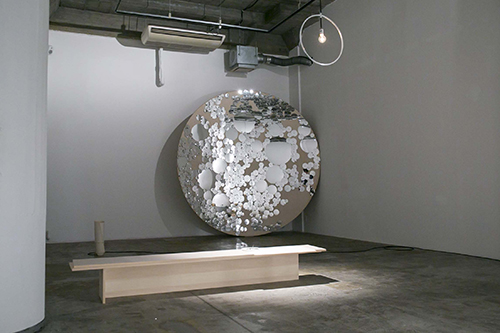
《Quantize #5》2015
Sound, light bulbs, aluminum, brass, wood, georgette, paper, clock movements, mechanical pencil leads, mirrors, batteries, etc. / 6000 x 12000 x 5000mm

Quantize #5 part
Takashi Ishida
http://www.nissan-global.com/JP/CITIZENSHIP/NAA/FINALIST/03/
Ishida, who works as a painter and filmmaker, as well as a performer, focuses on the movement of the whole body when painting, and by developing it into drawing animation, expresses traces of the body and time. The new works in this exhibition are inspired by several short stories by Edgar Allan Poe, and further explore the themes of "windows and walls," which Ishida has repeatedly faced in the past, as well as "vortexes" and "repetition." The moving lines of the paintings, the body, and the trajectories of time dynamically emerge from the video, which explores the act of seeing and drawing to its fullest. Upcoming events include a live screening at the Museum of Modern Art, Kamakura, Kanagawa Prefecture, in November 2015, "It Started in Kamakura. 1951-2016 PART 3," and participation in the "Aichi Triennale 2016."

"Square Window" 2015 / HD video / 6 minutes 30 seconds

Part of the wall used for "Square Window"
Takahiro Iwasaki
http://www.nissan-global.com/JP/CITIZENSHIP/NAA/FINALIST/04/
Iwasaki creates works that reconstruct familiar scenes such as construction sites using everyday items, as well as meticulous sculptures of historical architecture at various scales, expressing our world from multiple angles. In this exhibition, he will present a new work in which the half-destroyed Rashomon gate from Akira Kurosawa's film Rashomon is used as a motif, and the virtual image reflected in a puddle is also made into a three-dimensional work, blending reality and fiction together. The other work, a group of iron towers made from hair, recalls the scene of an old woman and her hair in the novel Rashomon by Ryunosuke Akutagawa, on which the film is based. These pieces seem to intertwine the world of Rashomon, devastated by war and disasters, with the shadow of smoldering conflict and modern society in extreme confusion after 70 years since the end of the war, and unprecedented disasters. In future exhibitions, he has created a window display for Hermes, which has been renovated and reopened at Seibu Ikebukuro Main Store, which is currently being held, and will be exhibited in a collection exhibition at Kawasaki City Museum from January 2016.
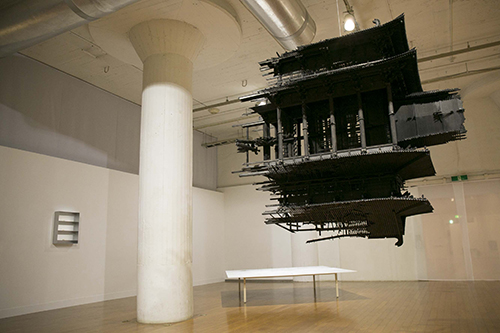
Photo on the right: Reflection Model (Rashomon Effect) 2015
Cypress, China veneer, India ink, wire/1800×1850×900mm

Out of Disorder (Has no grass grown for 70 years?) 2015
Human hair/600×2400×2400mm
Futoshi Miyagi
http://www.nissan-global.com/JP/CITIZENSHIP/NAA/FINALIST/05/
Miyagi has been working on a variety of media, including photography, video, objects, and text, addressing themes such as nationality, race, and identity while confronting his own memories and experiences. The new video installation is a part of a series of research projects dealing with Okinawa and sexual minorities, "American Boyfriend," which Miyagi has been working on since 2012. For the new work, Miyagi conducted research and interviews in Okinawa and the United States. The core video work depicts landscapes filmed in Okinawa and the United States, a violinist playing an American soldier, and a piece of music performed by an Okinawan pianist in the story, and tells the story of the process by which the two men come together, as well as the history and complex relationship between Okinawa and the United States. Upcoming activities include the worldwide tour of "Other People's Time" to the Singapore Art Museum (November 2015 - February 2016) and the Queensland Art Gallery | Museum of Contemporary Art (June - September 2016), as well as "Roppongi Crossing 2016" at the Mori Art Museum.
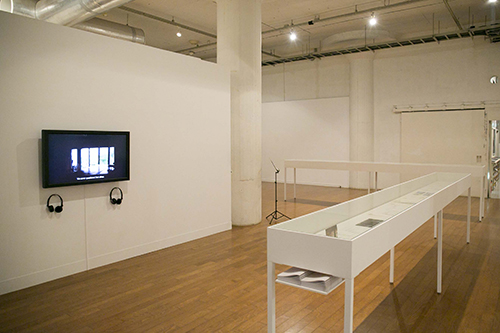
Photo on the left: About Raindrops, 2015 / Single channel video (color, sound) / 7 minutes 25 seconds
Photo on the right: 17 Notes from the South, 2015 / envelopes, postcards, stamps, digital prints, found photos, CD, ink on paper / size variable

Part of "17 Notes from the South"
Yuko Mohri
http://www.nissan-global.com/JP/CITIZENSHIP/NAA/FINALIST/06/
Mohri, who creates installations that incorporate three-dimensional objects made from everyday items and machines into the environment and allow viewers to sense invisible forces such as magnetism, gravity, and light, has been presenting his fieldwork series "More More Tokyo" since 2009, focusing on water leaks he sees in train stations and photographing ways to deal with them. Mohri sees the origin of his artistic idea of "beauty of utility" in the puri-collage (dexterous work) of station staff who try to stop water leaks by improvising everyday items together, and developed the series for this exhibition, working on a new work in Yokohama. Through two-dimensional compositions that deal with water leaks, he captures the aspects of cities that we have not paid attention to with a humorous and critical eye. Upcoming activities include participating in the exhibition "THE BEGINNINGS (or Open-Ended)" (Potluck Building Gallery) and "Roppongi Crossing 2016" (Mori Art Museum).
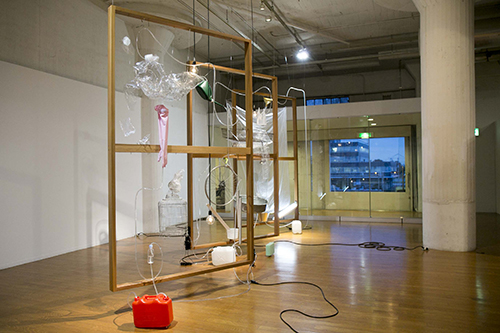
"More More: Given Falling Water #1-3" 2015
Wood, umbrella, hose, plastic bottle, rubber gloves, bucket, wheel, dust cloth, sponge, pump, acrylic resin, etc. / each 2725 x 1758 x 500 mm (x 3)

"More More: Given Falling Water #1-3" part
Tomoko Yoneda
http://www.nissan-global.com/JP/CITIZENSHIP/NAA/FINALIST/07/
Through careful research into history and places, Yoneda projects not only what is visible in reality, but also the memories hidden within, centering on the fundamental role of photography as a record. For this exhibition, Yoneda researched landscapes, people, and objects related to the history of World War II in particular, and took new photographs in the UK, Korea, and Japan, including the site of a B-29 crash, the military demarcation line that divides the Korean peninsula into North and South, and Tsuguharu Foujita, whose war documentary paintings were denounced after the war. In addition to these, he has lined up older works inspired by Yasukuni Shrine and Hiroshima, developing the series into one that reexamines the past and present from various historical fragments. As for future activities, Yoneda will be participating in the exhibition "Disjointed Harmony" (Hiroshima City Museum of Contemporary Art) starting this December, as well as an exhibition at the Kuandu Museum of Art in Taiwan and the "REAL DMZ" exhibition (Art Sonje Center, Korea) in 2016.

From the left
"Two entwined pine trees beyond the border (Northeastern frontier between North and South Korea, Goseong, South Korea) (from the "DMZ series")" / 2015 / Chromogenic print / 830 x 650 mm
"Bullet holes on the wall of an ice storage facility from the Japanese colonial period (Cherwon, a fierce battleground of the Korean War, near the DMZ, South Korea) (from the "DMZ series")" / 2015 / Chromogenic print / 650 x 830 mm
"Tsuguharu Foujita's Glasses - Telegram sent to GHQ Civil Administrator Sherman who helped him leave Japan (from the "Between Visible and Invisible" series)" / 2015 / Gelatin silver print / 1200 x 1200mm

Photo on the left: "Bikini Atoll nuclear test photo reconnaissance plane B-29 crash site / Peak District, England" 2015 / Chromogenic print / 1030 x 1300mm
Right: From the exhibition by Tomoko Yoneda
As you can see, all the works by the seven finalists are well worth seeing! Admission to the exhibition is free. Don't miss this opportunity to experience "the current state of Japanese contemporary art."

